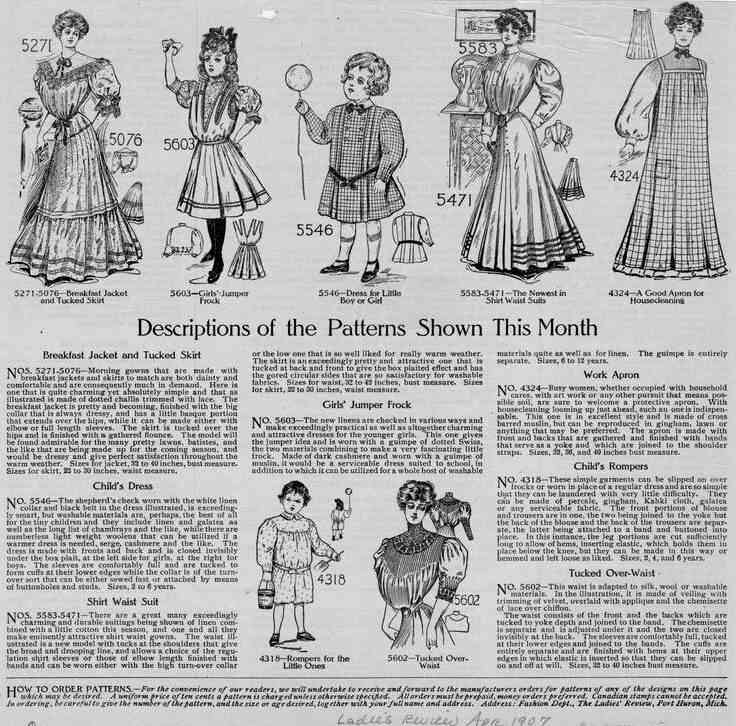
Ladies Review Patterns (1907)

Figure 1.--We note a 'Ladies Review' 1907 issue with patterns. There were various garments for women, but there were three items for children as well, a romper, jumper dress, and tunic. The editors used the term dress rather than tunic. The 'Ladies Review' is not a publication we know much about yet.
|
|
We note a Ladies Review 1907 issue with patterns. There were various garments for women, but there were three items for children as well, a romper, jumper dress, and tunic. The editors used the term dress rather than tunic. The Ladies Review is not a publication we know much about yet. It appears to have been a publication designed to market Butterick patterns.
Ladies Review
We do not know a great deal about the Ladies Reciew. I think the magazine was one of several fashion/pattern magazines founded by Robert S. O'Loughlin. [Mott, p. 482.] The patterns apparently were Butterick patterns. The magazine apparently was one of several magazines designed to market Butterick patterns. We are not sure wen it was founded, we think probably the 1880s. And we note the magazine still offering patterns in the 1920s. It seems to haved docused oin fashions for women and younger children.
Butterick was founded by Ebeneezer Butterick, a taylor in Stirling, Massachusetts during the Civil War in 1863. He revolutionized the home sewing when he created graded sewing pattern. The inspiration was his wife Ellen who complained that it would be eassier to sew with a pattern. . We do not yet have any of the earliest patterns. We do have a 1900 pattern for a 1900 fancy Fauntleroy blouse. The company continues to be a major force in home and still offers patterns for home sewing. The company in itspromotional literature says that it continues to lead the way in make-it-yourself fashions. I'm not sure just when Butterick began marketing patterns.
Children Patterns
We note a Ladies Review (April 1907) issue with patterns. There were various garments for women, but there were three items for children as well, a romper, jupper dress, and tunic. The editors used the term dess rather than tunic.
4318: Child's rompers
Rompers became a najor style for children in the 1900s. Here we see a romper suit pattern for both boys and girls. The ad copy suggests that the rompers her could be worn like amock over aress, but we do not quite undrstand how that would work. The ad copy read, "These simple garments can be slipped on over frocks or worn in place of a regular dress and are so simple that they can be laundered with very little difficulty. They can be made of percale, ginham, Khaki cloth, galatea or any other serviceanle fabric. The front portions of blouse and trousers are in one, the two being joined to the yoke, but the back of the blouse and the basck of the trousers are seperable, the later bring attached to a band abd buttined inton place. In this instance, the leg portions are cut sufficiently long to allow of hems, inserting elastic which holds them in plsace below the kneem but tey van be made in this way or hemmed and let loose as liked. Sizes, 2, 4, and 6 years."
5603: Girl's jumper frock
The term jumper had various commotations. Here we see a dress described as a jumper. We are not sure when the term was first used. We are not entirely sure what about the dress made it a jumper. We do note that the the girl wore a blouse and that straps attached to the skirt held it up. This is one definiton of auper dress. We do not know why the term "jumoer" was chosen for this style of dress.
5546: Child' dress (tunic)
The Ladies Review offered what they called a child's dress. Child of course meant that it could be worn by younge boys and girls. It looked like the tunic boys were eearing at the time. It was not a tunic suit as it did not include the bloomer knickers which boys, but not girls wore with these outfis. The tunic suit had by 1907 become a najor style for younger boys. It was a garment that coukld be worn for pboth play and cressing up, although the dressy tunic suits might have fancy detailing lacking here. The ad copy read, "This shepherd's check woirn with the white linen collar and black belt in the dress [illustrated], is exceedingly smart, but washable materials, are perhaps, the best of all for the tiny children and they include linnen and galaeta, as well as the long list of chambrays and the like, while there are mumberless light-weight woolens that can be utilized if a warmer dress is needed, serge, cashmere and the like. The dress is made with fronts and bsacks and is closed invisably unfer the b0x plait, at the left side gor girls, at the right side for boys. The sleeves are comfortably full anbd are tucked to irm cuffs at the lower edges while the collar is of the turnover sort that can be either sold fast or attached by means of buttonholes ans studs. Sizes, 2 t0 6 years."
Sources
Mott, Drank Luther. A History of American Magazines Vol. III (1865-1885).
HBC

Navigate the Boys' Historical Clothing catalog/magazine pages:
[Return to the Main 1907 catalog page]
[Return to the Main 1900s catalog pagepage]
[Main photo/publishing page]
[Store catalogs]
[Fashion magazines]
Navigate the Boys' Historical Clothing Web Site:
[Introduction]
[Activities]
[Biographies]
[Chronology]
[Cloth and textiles]
[Clothing styles]
[Countries]
[Topics]
[Bibliographies]
[Contributions]
[FAQs]
[Glossaries]
Images]
[Images]
[Links]
[Registration]
[Tools]
[Boys' Clothing Home]
Navigate the Boys' Historical Clothing Web Site:
[Sailor hats]
[Sailor suits]
[Buster Brown suits]
[Eton suits]
[Rompers]
[Kneepants]
[Knickers]
[Tunics]
[Smocks]
[Pinafores]
[Long stockings]
[Underwear]
Created: 9:27 PM 10/26/2009
Last updated: 9:27 PM 10/26/2009



